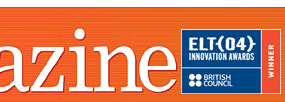 |
 |
 |
 |
 |
 |
|
|
|||||||||||||||||||||||||||||||||
COLUMNS |
First in a series of articles on Business English issues
If you are a new or even an experienced English Language Teaching (ELT) professional, you might be considering trying Business English (BE) teaching or training. Perhaps you are thinking over these questions: By going through the questions one by one, I will try to clarify these core BE concepts and issues. What is BE exactly? Is there any real difference between General English (GE) and BE? There are varying definitions of BE, according to which ELT specialist you might follow. Basically, I see BE as language development in a business setting. It is identical to GE in that it covers the same teaching/learning progression for language. However, the situational context puts BE in a different category. Grammar and lexis are deliberately presented in a workplace setting. This special business focus is a direct result of professionals needing the English language to meet the function of their daily work tasks. Thus the ideal BE teaching/learning environment has a balanced aim of combining language and business skills. Is BE the same as English for Special Purposes (ESP)? The issue of ESP compared to BE is in itself a controversial area of discussion. Some will argue that ESP is definitely in a class of its own, separate from BE. I tend to view ESP as involving the specific technical or specialised areas inside BE. You can think of professions in the automotive industry, engineering, medicine or law. These fields imply certain technical skills with special training, yet they still assume the same business practices and strategies found in other business sectors. Even if ESP is treated as an entirely different category, its targets in language and skill development are the same as in BE — to learn English to function effectively in the workplace. What types of business skills are covered in BE? BE concentrates on developing the language and style of typical business skills. It is not that a student may not know these skills in his own language and business context, but BE stresses the difference in style that is necessary for conducting business in English. The lexical focus then is on polite language that invites, establishes and maintains good business. These skills are communication oriented for dealing with customers or clients, colleagues and other professionals in one's field. The entire range of general to specific business situations is covered in BE. The skill areas can be broken down in the following manner:
The typical target language includes register (formality/informality), using polite and conditional forms and appropriate lexis. What qualifications do I need to teach BE? Must I have business background to do this kind of teaching? Both your academic and teaching experience in ELT are naturally a prerequisite for going into BE. Any of the special BE certificates from university or teacher training programmes are a definite plus, but not completely necessary for teaching BE. If you are confident with your teaching experience, especially with your classroom management and lesson organisation, then you will transfer well into BE. (See more about this in the comments on lesson formats and materials below.) You may hear that BE is just for teachers or trainers with some business background. Of course, that is the ideal situation for going into BE because business experience will bring a solid understanding to the language and skills you will teach. However, I would venture to say that if you are interested in business, then that would more than suffice. In your preparation and teaching of BE, you will indeed accumulate a wealth of knowledge about the business world, not just for your students, but for yourself as well. Your genuine interest and enthusiasm about business are the key to being a successful and happy BE teacher. Is there a special teaching focus in BE? The teaching focus and plan in BE should reflect the students' or participants' work context. The specifics of such a focus are usually derived from a needs analysis designed to find out the needs of both the company and individual employees. In the case of BE given at language schools or universities, a needs analysis should also be done directly with the students at the onset of their courses. Here are some typical questions a needs analysis would include:
The answers provide a basis for formulating a relevant course plan and consequent teaching focus for the employees/students. Are there certain lesson formats or a specific structure that are suitable for BE? Since BE is typically focused on company or employee needs, the following lesson formats or structure lend themselves to BE teaching:
Any or all of these formats can be done either at the company or in the language school/services' own classroom setting. Compared to GE, BE is often required to be more flexible in its planning and execution, so the teaching will readily adapt to the work demands of the participants. What teaching methods and materials are particular to BE? Given the various lesson formats, BE is especially focused on interactive, student oriented teaching methods. Participants should actively engage in communication activities that can be easily transferred to their real work situations. For instance, brainstorming, discussion and role-play seem to be quite conducive to the BE setting. These can form or simulate practice that is nearly identical to the students' real-life work situation. Class time seems to provide the best opportunity for optimal practice. Depending on time allowed for participants' language training at the workplace, homework may not play a significant role in learner progression. BE coursebooks should be chosen carefully to meet both the language and skills needs of the participants. Any original material you bring in ought to reflect the same premise. Finally, authentic materials must be used from the students' own work such as their emails, reports, meeting agendas, etc. Your methods and materials have to combine effectively to make the lessons relevant to the students. I hope my comments have addressed any curiosity that you may have about teaching Business English. If you are indeed going to switch to BE, it can be a satisfying, rewarding experience. You are giving people an indispensable tool to compete in both local and international markets. This can only add to the students' sense of confidence and self-esteem as business professionals. Bowen, T. and Marks, J. Inside Teaching (Macmillan,
1994) www.onestopenglish.com/business_esp You'll find the following related material in this issue:
Look for more tips and activities on meetings in the October issue. Business English Issues will feature a discussion on dealing with intercultural training. |
||||||||||||||||||||||||||||||||
|
|
|||||||||||||||||||||||||||||||||